Giacomo Santoro da Giuliana, more commonly known as Jacopo Siculo, is so-called because he came from Sicily. He was documented in Rome in 1519, when he was working under Baldassarre Peruzzi. He was still in Rome in early 1527, and probably left after the sack of the city by Imperial troops later that year. He subsequently settled in Spoleto, where he married one of the daughters of Giovanni di Pietro, lo Spagna.
Spoleto
Work in Cappella dell' Assunta, Duomo (ca. 1535)
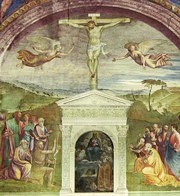
This work in the Cappella dell' Assunta, which is attributed to Jacopo Siculo, comprises:
-
✴the panel of the Assumption of the Virgin in an aedicule on the altar wall ; and
-
✴the frescoes on the walls of the chapel.
Madonna and Child with saints (1537)
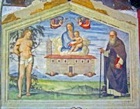
Work in San Brizio (1541-2)
This work in San Brizio, outside Spoleto, comprises:
-
✴the altarpiece (1542) of the Holy Family, which Bartolomeo Pancani (a canon of San Brizio) commissioned it from Jacopo Siculo; and
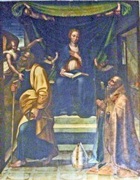
-
✴the frescoes above the triumphal arch that leads to the presbytery, which are dated by inscription and are attributed to him. These depict the Last Supper and Sibyls.

Bettona
Virgin in Glory with Saints (1547)
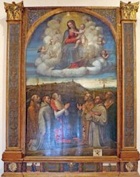
The main panel depicts the Madonna and Child in a mandorla of clouds and putti, with six kneeling figures below: SS Crispoltus; Francis; Jerome; (?); Antony of Padua; and Louis of Toulouse.

Norcia
Coronation of the Virgin (1541)
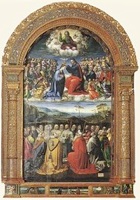
-
✴The landscape in the lower part of the main panel depicts the Convento dell’Annunzata, with the plain in front of it transformed into a lake.
-
✴The predella depicts:
-
•the Annunciation (at the extremes), in reference to the dedication of the church;
-
•St Jerome in the dessert;
-
•the Pietà; and
-
•the stigmatisation of St Francis.
The altarpiece, was removed from the church and dismembered so that the main panel could be exhibited in Perugia in 1907. The components were subsequently housed in San Benedetto and then, from 1967, in the Museo della Castellina. The components were taken to Spoleto for restoration after an earthquake in 1979, and remained there for some 25 years. The restoration was finally completed in 1994, and the reassembled altarpiece was returned to the museum.



